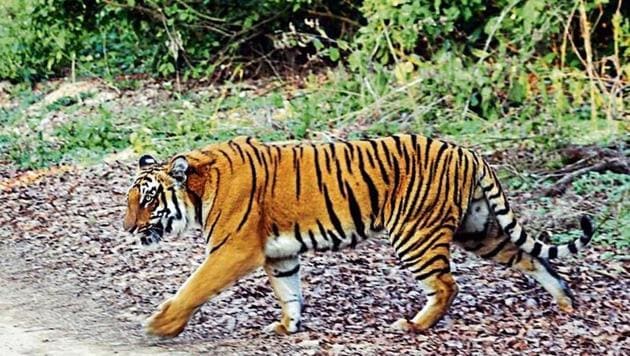Corbett Tiger Reserve security emerging as big challenge in Uttarakhand
On May 17, a suspected poacher, Abdul Rauf, was arrested by forest officials in Jhirna range of Corbett tiger reserve while trying to enter the core of Corbett Tiger Reserve (CTR) in Jhirna Zone.
The May 17 arrest of a suspected poacher from Corbett’s Jhirna range with a dead turtle in his possession has raised questions regarding the overall security in the Corbett landscape and the other challenges the reserve officials face. Corbett with its southern boundary with Uttar Pradesh continues to be on the target list of the poachers.

RK Tiwari, sub-divisional officer (SDO), forest, Kalagarh, said officials have been directed to investigate the matter and find out what the accused, a native of Assam, was doing in Corbett with a dead turtle. “There are many water bodies in and around Corbett. He has most likely taken this turtle from somewhere here. We are questioning him on many aspects and will soon know,” he said.
On May 17, a suspected poacher, Abdul Rauf, was arrested by forest officials in Jhirna range of Corbett tiger reserve while trying to enter the core of Corbett Tiger Reserve (CTR) in Jhirna Zone. In April, officials from Corbett Tiger Reserve arrested 40-year-old Bablu Kumar, a native of Meerut, Uttar Pradesh, in the Bijrani range of Corbett. He was found roaming in the protected forests of the range, and was booked under section 9 (prohibition of hunting) and section 30 (causing fire prohibited) of the Wildlife (Protection) Act, 1972.
Apart from the threat of the poachers, increasing man-elephant conflict and a surge in tiger numbers also pose challenges to the reserve. According to Shivraj Chand, warden of Corbett tiger reserve, the administration has requested 300 additional patrolling staff to help deal with the rising elephant and tiger numbers. There are 300 regular patrolling staff right now.
According to forest officials, members of Bawariya community who are traditionally involved in a nomadic life and hunting wild animals, have poached tigers from the reserve. Bawariyas have been arrested in the state earlier for tiger poaching. In May 2012, after a tiger-poaching incident was reported in Corbett Tiger Reserve, a series of raids and investigations followed, and eight Bawariyas were arrested in Haryana. During Navratras, they offer the first blood of wild animals before the Goddess.
The issue of an effective mechanism for dealing with wildlife crime in the state was raised in the Uttarakhand high court in March this year. In a public interest litigation (PIL) related to the seizure of skins of five tigers and around 130kg bones suspected to be of tigers from poachers in the Corbett Tiger Reserve in March 2016, the HC asked the state government to inform the court on the action taken by it regarding the formation of wildlife crime control bureau in the state.
The Park is also facing manpower issues due to the vast landscape that needs to manned, which it wants to compensate with technological initiatives like drones and high tech surveillance cameras. In April, Corbett administration also decided to set up eleven new thermal cameras on the watch towers in CTR with a range of up to four kilometres for online surveillance on intruders and poachers and wild animals in the national park. Nine of the eleven cameras will be set up on the watch towers in the southern boundary of the park, Kalagarh zone. The southern boundary of Corbett, spreading over 70 km, is vulnerable to poaching.
There are other main issues in the Corbett landscape. One is how Corbett landscape in Ramnagar is becoming the main route for smuggling of marijuana and hashish from the hill districts like Almora and Bageshwar to the plains, especially Uttar Pradesh. Another is how illegal country-made liquor makers are using forest areas around Corbett Tiger reserve in Ramnagar to operate illicit liquor distillation units.
Claimed to have one of the highest tiger densities in the world, Corbett has around 215 (169 to 261) tigers according to the last estimate. Corbett has a rich biodiversity including around 110 tree species, 50 species of mammals, 580 bird species, 33 species of reptiles, seven species of amphibians and so on. The park extends over 1,288 sq km spread over three districts of Uttarakhand namely Pauri Garhwal, Nainital and Almora






